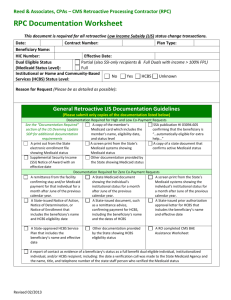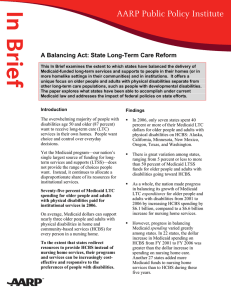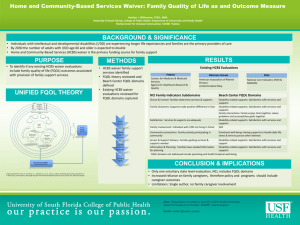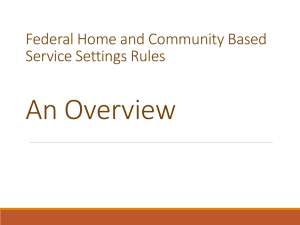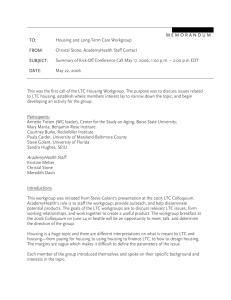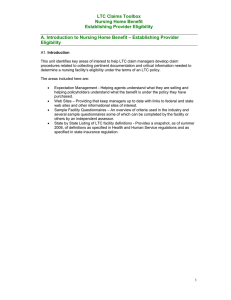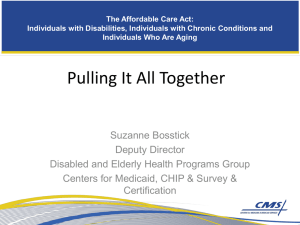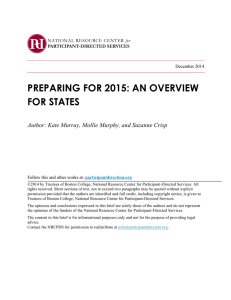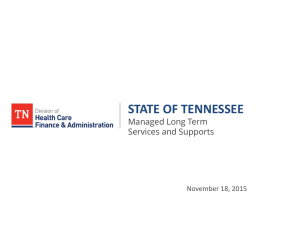Balancing LTC: Can More Home- and g Community-Based Support Save Money Whil I
advertisement
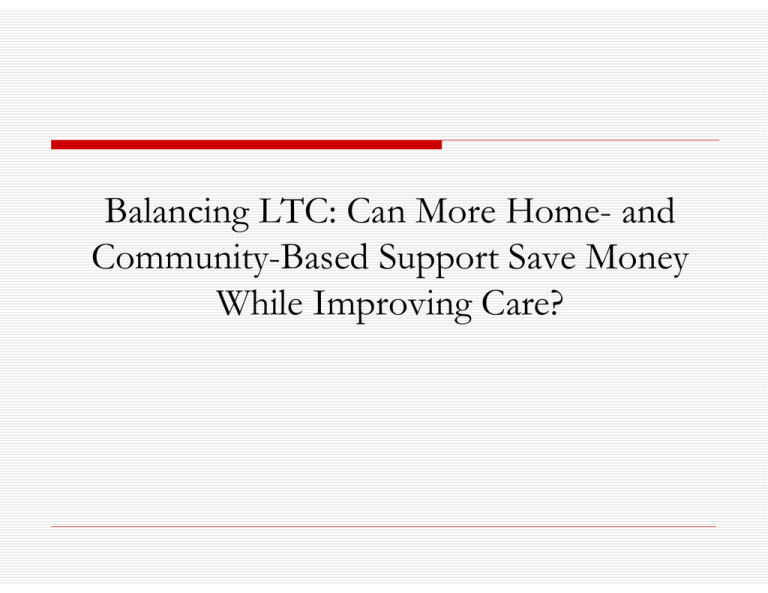
Balancingg LTC: Can More Home- and Community-Based Support Save Money Whil IImproving While i C Care?? The Cost Cost-effectiveness effectiveness of HomeHome and Community-Based Services David C. Grabowski, PhD Harvard Medical School Balancing of LTC • LTC system historically dominated by nursing homes • In recent years, huge growth in delivery of LTC in noninstitutional settings • HCBS often preferred by consumers/families • Hope of lower cost HCBS • Also pushed as a civil rights issue, especially by the disability community • Olmstead decision Rebalancing Medicaid LTC Expenditures 100% 80% 60% 40% 20% 0% 1992 1994 1996 1998 Institutional 2000 2002 2004 2006 HCBS Source: Thomson Reuters via CMS Form 64 -1 30 ° -120° -110° -1 00° -90 ° -80° -70° -60° Percent of Medicaid LTC p g for HCBS Spending 40 ° 40 ° Canada Pacific Ocean Mexico Gulf of Mexico -120° -110 ° -1 30 ° 30 ° 30 ° Atlantic Ocean -120° -100° -110° -90° -1 00° -90 ° 1997 -80° -80° -70° -60° 30° Atlantic Ocean Pacific Ocean Mexico Gulf of Mexico 2007 -120° -110 ° -100° -90° -80° 30 ° 40 ° 40 ° Canada Alabama Alaska Arizona Arkansas California Colorado Connecticut Delaware District of Columbia Florida Georgia Hawaii Idaho Illinois Indiana Iowa K Kansas Kentucky Louisiana Maine Maryland Massachusetts Michigan Minnesota Mississippi Missouri 1997 17.5% 38.1% 6.5% 21 6% 21.6% 20.3% 39.2% 26.0% 22.0% 5.6% 18.0% 18.1% 12.9% 20.6% 11.2% 7.8% 17.8% 31 8% 31.8% 24.0% 9.4% 28.1% 28.4% 25.0% 26.7% 29.7% 4.5% 26.3% 2007 28.4% 62.6% 64.0% 30 1% 30.1% 54.3% 51.6% 35.5% 35.4% 32.6% 34.4% 38.3% 39.9% 43.6% 31.4% 33.3% 37.7% 53 4% 53.4% 30.2% 36.2% 51.4% 41.1% 38.7% 33.3% 62.9% 12.7% 44.9% Montana Nebraska Nevada New Hampshire New Jersey New Mexico New York North Carolina North Dakota Ohio Oklahoma Oregon Pennsylvania Rhode Island South Carolina South Dakota T Tennessee Texas Utah Vermont Virginia Washington West Virginia Wisconsin Wyoming 1997 31.3% 24.9% 16.9% 35 7% 35.7% 24.1% 42.0% 34.2% 27.7% 18.1% 20.3% 23.1% 50.3% 12.5% 35.4% 20.9% 26.4% 9 3% 9.3% 24.0% 31.0% 46.5% 25.1% 35.9% 31.0% 28.3% 38.6% 2007 45.0% 37.6% 45.3% 39 6% 39.6% 29.6% 72.9% 47.4% 44.9% 25.6% 30.1% 42.5% 72.7% 28.3% 45.6% 34.7% 39.1% 29 9% 29.9% 42.5% 38.6% 28.5% 39.6% 61.8% 41.4% 46.1% 55.7% Overview • Home- and community-based services have clearly grown in use • Gi Given nb budget d tn neutrality tr lit rrestrictions, tri ti n th there r h has b been n a llott int interest r t in establishing that they also save $$$ • Lower per-person cost, but potential moral hazard or “woodwork effect effect” • Challenge of “targeting” services to those at highest risk of institutionalization • Review of the evidence on this issue • Grabowski, Grabowski D.C., D C 2006 2006, “The The Cost Cost-Effectiveness Effectiveness of Noninstitutional Long-Term Care Services: Review and Synthesis of the Most Recent Evidence,” Medical Care Research and Review 63(1): 3-28. Three types of HCBS evaluations • Randomized, controlled experiments (e.g., Channeling) • Medicaid waiver spending studies • Capitation (e.g., PACE) Summary of the literature to date • Achieving cost savings with HCBS has proven difficult • Relative to “non-HCBS” comparison, three different types of research have found: • HCBS associated with higher costs • HCBS associated with roughly similar care outcomes g quality-of-life, q y • HCBS associated with higher satisfaction Are We Asking the Right Question? • For budgetary reasons, we often ask the question from the title of this session: “Can Greater HCBS Save Money?” • The literature suggests no, but we persist with the need to establish cost savings: • State LTC program officer: “Why would we continue a program that lost money?” • Perhaps we should be asking: “What What are we getting in return for increased HCBS $$$? $$$?” • More difficult to answer • Society provides “nursing home care with little expectation of positive outcomes and complete p certaintyy of increased expenditures.” p – Weissert et al.,, 1988 Milbank Q • LTC “Experts” clearly believe HCBS add sufficient value to warrant further expansion • 84% of respondents to Commonwealth Fund’s LTC Opinion Leader Survey (N = 1,147) supported further growth of HCBS (Grabowski et al., In press MCRR) Today’s Session • Chuck Milligan on cost-effectiveness for dual eligibles: • Need to consider Medicaid waiver $$$ AND Medicare $$$ • Randy Brown on Cash and Counseling • What is the most cost effective HCBS model? • Peter Arno and Deborah Viola on the caregiver workforce • Recruitment of workers; Consideration of informal caregivers
